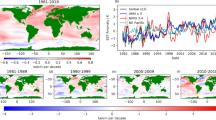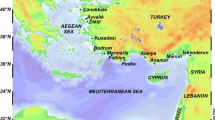Abstract
This study used the synthetic running correlation coefficient calculation method to calculate the running correlation coefficients between the daily sea ice concentration (SIC) and sea surface air temperature (SSAT) in the Beaufort-Chukchi-East Siberian-Laptev Sea (BCEL Sea), Kara Sea and southern Chukchi Sea, with an aim to understand and measure the seasonally occurring changes in the Arctic climate system. The similarities and differences among these three regions were also discussed. There are periods in spring and autumn when the changes in SIC and SSAT are not synchronized, which is a result of the seasonally occurring variation in the climate system. These periods are referred to as transition periods. Spring transition periods can be found in all three regions, and the start and end dates of these periods have advancing trends. The multiyear average duration of the spring transition periods in the BCEL Sea, Kara Sea and southern Chukchi Sea is 74 days, 57 days and 34 days, respectively. In autumn, transition periods exist in only the southern Chukchi Sea, with a multiyear average duration of only 16 days. Moreover, in the Kara Sea, positive correlation events can be found in some years, which are caused by weather time scale processes.
Similar content being viewed by others
References
Bitz, C. M., Battisti, D. S., Moritz, R. E., and Beesley, J. A., 1996. Low-frequency variability in the Arctic atmosphere, sea ice, and upper-ocean climate system. Journal of Climate, 9 (2): 394–408.
Cohen, J., Screen, J. A., Furtado, J. C., Barlow, M., Whittleston, D., Coumou, D., Francis, J., Dethloff, K., Entekhabi, D., Overland, J., and Jones, J., 2014. Recent Arctic amplification and extreme mid-latitude weather. Nature Geoscience, 7 (9): 627–637.
Comiso, J. C., Parkinson, C. L., Gersten, R., and Stock, L., 2008. Accelerated decline in the Arctic sea ice cover. Geophysical Research Letters, 35 (1): L01703.
Curry, J. A., Schramm, J. L., and Ebert, E. E., 1995. Sea ice-albedo climate feedback mechanism. Journal of Climate, 8 (2): 240–247.
Eastman, R., and Warren, S. G., 2010. Interannual variations of Arctic cloud types in relation to sea ice. Journal of Climate, 23 (15): 4216–4232.
Francis, J. A., and Hunter, E., 2006. New insight into the disappearing Arctic sea ice. Eos, Transactions American Geophysical Union, 87 (46): 509–511.
Gorodetskaya, I. V., and Tremblay, L., 2008. Arctic cloud properties and radiative forcing from observations and their role in sea ice decline predicted by the NCAR CCSM3 model during the 21st century. In. Arctic Sea Ice Decline: Observations, Projections, Mechanisms, and Implications. DeWeaver, E. T., ed., American Geophysical Union, Washington, D. C., 47–62.
Ji, X., and Zhao, J., 2015. Analysis of correlation between sea ice concentration and cloudiness in central Artic. Haiyang Xuebao, 37 (11): 92–104 (in Chinese with English abstract).
Kaleschke, L., Girard-Ardhuin, F., Spreen, G., Beitsch, A., and Kern, S., 2018. ASI Algorithm SSMI-SSMIS sea ice concentration data, originally computed at and provided by IFRE-MER, Brest, France, were obtained as 5-day median-filtered and gap-filled product for 1992–2016 from the Integrated Climate Date Center (ICDC, icdc.cen.uni-hamburg.de/), University of Hamburg, Hamburg, Germany. Available at: {rs http://icdc.cen.uni-hamburg.de url}/1/daten/cryosphere/seaiceconcentration-asi-ssmi.html, last access: 12 January 2018.
Kalnay, E., Kanamitsu, M., Kistler, R., Collins, W., Deaven, D., Gandin, L., Iredell, M., Saha, S., White, G., Woollen, J., Zhu, Y., Leetmaa, A., Reynolds, B., Chelliah, M., Ebisuzaki, W., Higgins, W., Janowiak, J., Mo, K. C., Ropelewski, C., Wang, J., Jenne, R., and Joseph, D., 1996. The NCEP/NCAR 40-year reanalysis project. Bulletin of the American Meteorological Society, 77 (3): 437–471.
Kay, J. E., L’Ecuyer, T., Gettelman, A., Stephens, G., and O’Dell, C., 2008. The contribution of cloud and radiation anomalies to the 2007 Arctic sea ice extent minimum. Geophysical Research Letters, 35 (8): L08503.
Liu, Y., Key, J. R., and Wang, X., 2009. Influence of changes in sea ice concentration and cloud cover on recent Arctic surface temperature trends. Geophysical Research Letters, 36: L20710.
Markus, T., Stroeve, J. C., and Miller, J., 2009. Recent changes in Arctic sea ice melt onset, freezeup, and melt season length. Journal of Geophysical Research: Oceans, 11 4 (C12): C12024.
Overland, J. E., Adams, J. M., and Bond, N. A., 1997. Regional variation of winter temperatures in the Arctic. Journal of Climate, 10 (5): 821–837.
Peng, G., and Meier, W. N., 2017. Temporal and regional variability of Arctic sea-ice coverage from satellite data. Annals of Glaciology, 59: 191–200.
Screen, J. A., and Simmonds, I., 2010. Increasing fall–winter energy loss from the Arctic Ocean and its role in Arctic temperature amplification. Geophysical Research Letters, 37 (16): L16707.
Schweiger, A. J., 2004. Changes in seasonal cloud cover over the Arctic seas from satellite and surface observations. Geophysical Research Letters, 31 (12): L12207.
Serreze, M. C., and Barry, R. G., 2011. Processes and impacts of Arctic amplification: A research synthesis. Global and Planetary Change, 77 (1-2): 85–96.
Serreze, M. C., and Barry, R. G., 2014. The Arctic Climate System. Cambridge University Press, Cambridge, 51–53.
Serreze, M. C., and Francis, J. A., 2006. The Arctic amplification debate. Climatic Change, 76 (3-4): 241–264.
Serreze, M. C., Holland, M. M., and Stroeve, J., 2007. Perspectives on the Arctic’s shrinking sea-ice cover. Science, 315 (5818): 1533–1536.
Sirevaag, A., Rosa, S. D. L., Fer, I., Nicolaus, M., Tjernström, M., and McPhee, M. G., 2011. Mixing, heat fluxes and heat content evolution of the Arctic Ocean mixed layer. Ocean Science Discussion, 7 (3): 335–349.
Smith, D. M., 1998. Recent increase in the length of the melt season of perennial Arctic sea ice. Geophysical Research Letters, 25 (5): 655–658.
Solomon, S., 2007. Climate Change 2007–. The Physical Science Basis: Working Group I Contribution to the Fourth Assessment Report of the IPCC. Vol. 4. Cambridge University Press, Cambridge, 996–997.
Soon, W. W. H., 2005. Variable solar irradiance as a plausible agent for multidecadal variations in the Arctic–Wide surface air temperature record of the past 130 years. Geophysical Research Letters, 32 (16): L16712.
Stroeve, J. C., Markus, T., Boisvert, L., Miller, J., and Barrett, A., 2014. Changes in Arctic melt season and implications for sea ice loss. Geophysical Research Letters, 41 (4): 1216–1225.
Zhang, J., Lindsay, R., Schweiger, A., and Steele, M., 2013. The impact of an intense summer cyclone on 2012 Arctic sea ice retreat. Geophysical Research Letters, 40 (4): 720–726.
Zhao, J., Cao, Y., and Shi, J., 2006. Core region of Arctic oscillation and the main atmospheric events impact on the Arctic. Geophysical Research Letters, 33 (22): L22708.
Zhao, J., Cao, Y., and Wang, X., 2018. The physical significance of the synthetic running correlation coefficient and its applications in oceanic and atmospheric studies. Journal of Ocean University of China, 17 (3): 451–460.
Acknowledgments
This work was supported by the National Major Science Project of China for Global Change Research (No. 2015CB953900) and the National Natural Science Foundation of China (No. 41330960).
Author information
Authors and Affiliations
Corresponding author
Rights and permissions
About this article
Cite this article
Ji, X., Zhao, J. Transition Periods Between Sea Ice Concentration and Sea Surface Air Temperature in the Arctic Revealed by an Abnormal Running Correlation. J. Ocean Univ. China 18, 633–642 (2019). https://doi.org/10.1007/s11802-019-3909-3
Received:
Revised:
Accepted:
Published:
Issue Date:
DOI: https://doi.org/10.1007/s11802-019-3909-3




